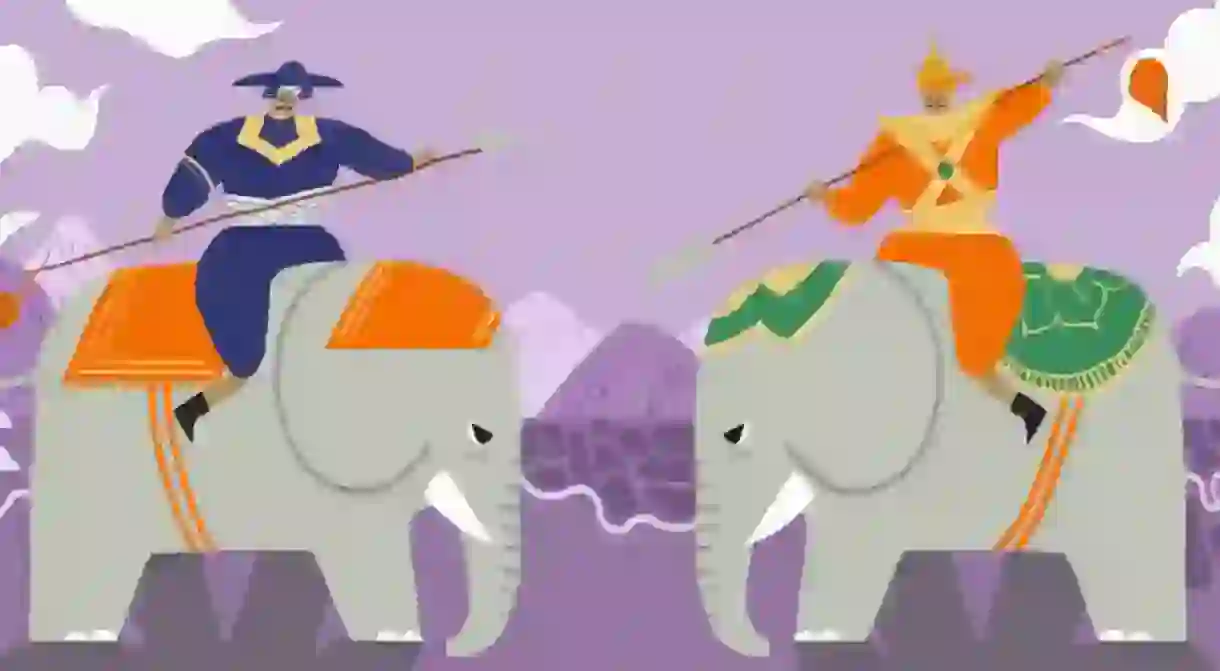The Epic Legend of Thailand's Elephant Battle

Elephants might be the much-loved symbol of Thailand today, yet in the past, they were used as instruments of war. One story of an elephant battle more than 400 years ago remains a source of pride for the Thai people even today — and here’s a little more about it.
A kingdom at war

In the late 16th century, Thailand wasn’t Thailand as we know it, but a number of different kingdoms, who were almost constantly warring with Burma. Lan Na Kingdom, which is now Chiang Mai, was under the control of Burma, and they tried several times to take land further south. Not content with just Lan Na, and reeling from previous defeats, the Burmese sought to push further south and attempted to take the Kingdom of Ayutthaya. King Naresuan, the ruler of Ayutthaya, planned to go to war in Cambodia due to their incursions into his kingdom, and had much of his army stationed near there. With little in the way of opposition, Burma made significant initial advances into Thailand. Finally, with his army in tow, Naresuan faced the Burmese in Nong Sarai.
Outnumbered but not outfought

Burma assembled a large army to take Ayutthaya, and Naresuan’s forces were severely outnumbered. A skilled military tactician, he knew that a straight fight wouldn’t lead to victory, so he devised a plan. Naresuan’s forces faked a retreat, baiting the Burmese into attacking them, when the main army of Ayutthaya would strike. Although this was an effective tactic, it wasn’t enough. Whilst Naresuan’s war elephants, aggressive from being in musth, charged into the Burmese forces, he spotted the Crown Prince of Burma, Mingyi Swa, resting atop an elephant in the shade under a tree. According to Thai history, Naresuan challenged the prince to a single combat duel. He accepted, and the rest is history.
Elephant battle

Accounts of the battle differ, depending on whether you’re Thai or Burmese, but the Thai narrative of the story is one that’s been etched into folklore. In January, 1953, the two leaders, perched atop their elephants, engaged in a fierce and heavily-romanticised duel. The Burmese prince was younger, fitter and had a better trained elephant, and Naresuan came close to suffering a fatal blow, escaping with just a cut on his face, but soon had the upper hand. He caught Mingya Swa off guard, and struck him with a blow which, according to some accounts, saw him cut in half from his right shoulder down to his left hip. The Burmese surrendered following the defeat of their prince, and the battle was over; Ayutthaya had once more repelled the mighty Burmese armies. The king built a pagoda on the spot where he was victorious, and his ngaw — the type of blade he used to kill the prince — and helmet were housed in it. Other accounts claim it wasn’t a duel, but the two did fight on the battle field, whereas the Burmese denied that their prince was killed by the king at all.
Legacy

Today, the elephant battle has become a huge part of the nation’s psyche and is remembered as one of its finest moments. Naresuan’s success here and in capturing other cities, along with freeing Thais from subjugation, saw him earn the title Naresuan the Great, and statues of him and his elephant battle can be found all over Thailand. As well as being featured in Thai language movies, the battle has also gained attention worldwide; the video game Civilization V features a unit called “Naresuan’s Elephant”,which is depicted as soldiers atop an elephant. However, not everyone buys this historical account. Sulak Sivaraska was arrested on lèse-majesté, or charged for questioning the historical accuracy of the battle, but the charges have since been dropped.













